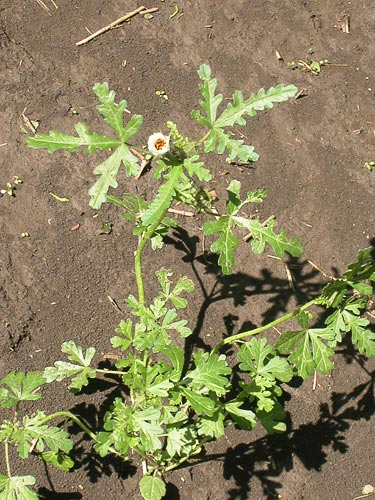Weeds
Hibiscus trionum L. - Ternate Hibiscus.
Systematic position.
Family Malvaceae, genus Hibiscus.Synonym.
Hibiscus vesicarius Cav.Biological group.
Annual weed.Morphology and biology.
Root stalky. Stem straight, more often branching, in nodes usually angularly bent. Covered with scattered rigid 2-3-apicate and fascicular hairs with two strips of softer, shorter hairs descending to the base of leaves. The lower branches can be lengthened, rising or even lying. Leaves alternate, petiolate; with petioles equal to blade or shorter, covered with dense and rigid hairs. Leaf blade usually integral or slightly lobate, rounded or cordate at base at the very first leaves; trilobate or tripartite with wide lobes at lower leaves; on all other stem leaves the blade is dissected to base into three, narrowed cuneately to the base, oblong segments (the median one is the longest). All leaves bare from above or with some simple setae along main ribs, green; from below they are pale, with split setae and with admixture of stellate hairs, frequently purple edged along margins. Stipules setiform-subulate, long-ciliated. Flowers single, pale yellow, with purple stain at base, located in leaf sinuses on long pedicels (being longer than or equal to petioles). Bell campaniform (bell-shaped), pale, with 20 longitudinal purple ribs. Bell bare or having stellate hairs between ribs, with fascicular hairs on ribs. Pedicels are densely covered with rigid hairs, having articulation below flower; the pedicel is sharply bent along the articulation at fruiting. Epicalix consisting of 10 to 13 linear, erect-ciliated sepals. Fruit is penta- or polyspermic hairy black boll with reniform or oval-cordate, convex, bare, richly warty seeds being 2-3 mm in length and 1.7-2.5 mm in width. Seeds red-brown to dark gray.Distribution.
The species originated from the Eastern Mediterranean. The general distribution includes Central Europe (south), the Mediterranean, Balkan peninsula and Minor Asia, Iran, Armenia, Kurdistan, India, Pakistan, Nepal, Northwest China (Xinjiang), Tibet, Mongolia, Japan, Korean peninsula and Northeast China, Indochina, Africa, Australia, and America. It was described from Italy and Africa. One type was imported to London. In the former USSR it is distributed in the European part (Black See coast region, Crimea, Middle Dnieper river basin (south), Volga-Don river basin (south), the Lower Don and Lower Volga river basins); in the Caucasus (Ciscaucasia, Dagestan, Western, Southern and Eastern Transcaucasia, Talysh Mountains); in Central Asia (Aral-Caspian, Balqash, Dzhungar-Tarbagatai, Mountain-Turkmen, Kara-Kum (Garagum), Kyzyl-Kum (Qyzylqum), Amu Darya, Syr Darya, Tian Shan, Pamirs-Alai districts); in Eastern Siberia (Daurskii district); in the Far East (Zeya, Bureya, and Ussuri river basins).Ecology.
It is widely distributed now on all continents, both in tropics and subtropics, occurring in southern steppes of the northern hemisphere. Within the limits of the former USSR it grows in all areas of irrigated agriculture, where it is a weed in cotton and other tilled crops. Occurs in ruderal habitats, on abandoned lands. It is insignificant as a weed.Economic significance.
Leaves of this plant are used for making syrup having a sudorific effect. The whole green plant contains about 0.3% rubber-like compounds. Seeds contain to 23% fat oil. It is sometimes cultivated as a decorative plant.Reference citations:
Cherepanov S.K. 1995. Vascular plants of Russia and adjacent states (of the former USSR). St. Petersburg: Mir I semya. 991 pp. (In Russian)Fisyunov A.V. 1984. Weeds. Moscow: Kolos. 320 pp. (In Russian)
Grossgeim A.A. 1949. Keys to plants of the Caucasus. Moscow: Sovetskaya nauka. 747 pp. (In Russian)
Maevskii P.F. 1954. Flora of middle belt of the European part of the USSR. Moscow & Leningrad: Selkhozgiz. 912 pp. (In Russian)
Nikitin V.V. 1957. Weed vegetation of Turkmenia. Ashkhabad: AN TurkmSSR. 581 pp. (In Russian)
Shishkin B.K., Bobrov E.G., eds. 1949. Flora of the USSR. Moscow & Leningrad: AN SSSR. V. 15: 742. (In Russian)


